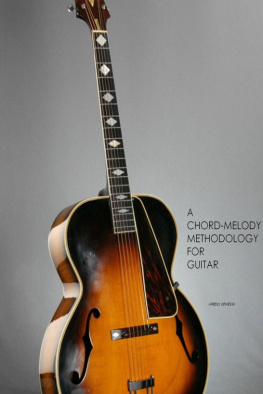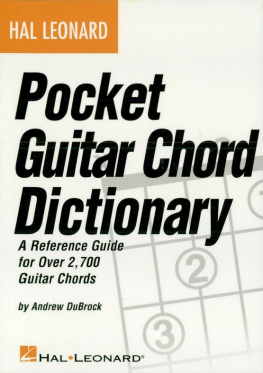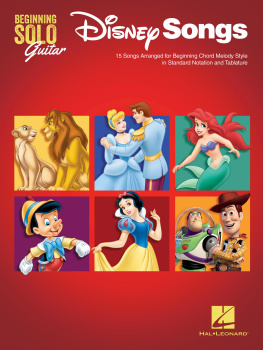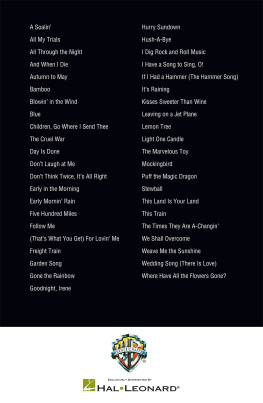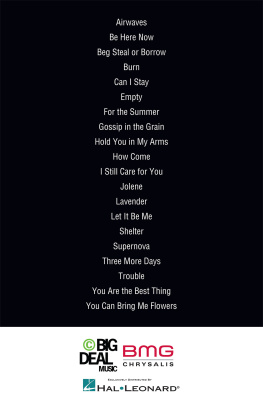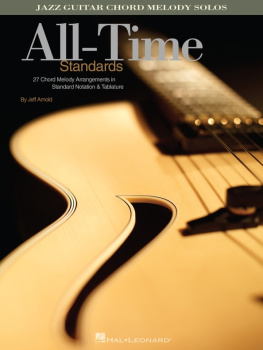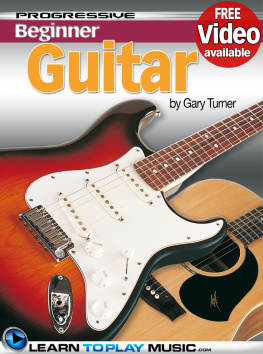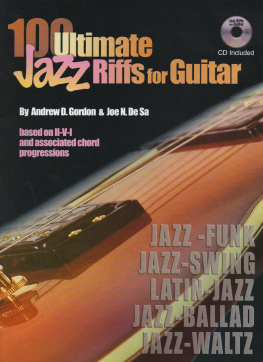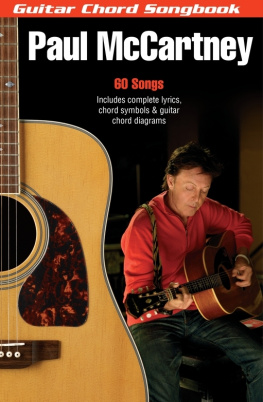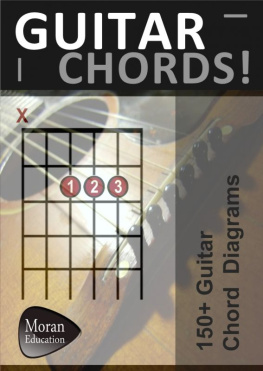Harold Combess - A Chord-Melody Methodology for Guitar
Here you can read online Harold Combess - A Chord-Melody Methodology for Guitar full text of the book (entire story) in english for free. Download pdf and epub, get meaning, cover and reviews about this ebook. year: 2014, publisher: Harold Combess, genre: Children. Description of the work, (preface) as well as reviews are available. Best literature library LitArk.com created for fans of good reading and offers a wide selection of genres:
Romance novel
Science fiction
Adventure
Detective
Science
History
Home and family
Prose
Art
Politics
Computer
Non-fiction
Religion
Business
Children
Humor
Choose a favorite category and find really read worthwhile books. Enjoy immersion in the world of imagination, feel the emotions of the characters or learn something new for yourself, make an fascinating discovery.
- Book:A Chord-Melody Methodology for Guitar
- Author:
- Publisher:Harold Combess
- Genre:
- Year:2014
- Rating:4 / 5
- Favourites:Add to favourites
- Your mark:
- 80
- 1
- 2
- 3
- 4
- 5
A Chord-Melody Methodology for Guitar: summary, description and annotation
We offer to read an annotation, description, summary or preface (depends on what the author of the book "A Chord-Melody Methodology for Guitar" wrote himself). If you haven't found the necessary information about the book — write in the comments, we will try to find it.
A Chord-Melody Methodology for Guitar — read online for free the complete book (whole text) full work
Below is the text of the book, divided by pages. System saving the place of the last page read, allows you to conveniently read the book "A Chord-Melody Methodology for Guitar" online for free, without having to search again every time where you left off. Put a bookmark, and you can go to the page where you finished reading at any time.
Font size:
Interval:
Bookmark:
TABLEOF CONTENTS CHORD STRUCTURES: SHAPES, FINGERINGS ANDSUBSTITUTIONS CHORD FORMS WITH 6TH STRING BASSNOTE FLATTED 7TH/MELODY ON 3RDSTRING FLATTED 7TH/MELODY ON 2NDSTRING FLATTED 7TH/MELODY ON 1STSTRING NATURAL 7TH/MELODY ON 3RDSTRING NATURAL 7TH/MELODY ON 2NDSTRING NATURAL 7TH/MELODY ON 1STSTRING DOUBLE FLAT 7TH (6TH)/MELODY ON 3RDSTRING DOUBLE FLAT 7TH (6TH)/MELODY ON 2NDSTRING DOUBLE FLAT 7TH (6TH)/MELODY ON 1STSTRING CHORD FORMS WITH 5TH STRING BASSNOTE FLATTED 7TH/MELODY ON 2NDSTRING FLATTED 7TH/MELODY ON 1STSTRING NATURAL 7TH/MELODY ON 2NDSTRING NATURAL 7TH/MELODY ON 1STSTRING DOUBLE FLAT 7TH (6TH)/MELODY ON 2NDSTRING DOUBLE FLAT 7TH (6TH)/MELODY ON 1STSTRING COMMENTARY SITUATIONAL EXAMPLES THE ii-V and vi-ii-V SECONDARY DOMINANTS AND THEIRTENSIONS II7 (V OF V) III7 (V OF vi) IV7 (V OF bVII) VI7 (V OF ii) VII7 (V OF iii) IMPLEMENTATION OF THE DIMINISHEDSTRUCTURE CHROMATIC APPROACHES WITH THE DIMINISHEDSTRUCTURE SEQUENTIAL MELODIES UTILIZING THEDIMINSHED STRUCTURE REPEATED TONES: MAJOR TONICSOUNDS THE ii-V: MOREEXAMPLES OMITTING CHORD TONES: EXAMPLES ANDGUIDELINES CONTRARY MOTION BETWEEN BASS ANDMELODY HARMONIZING EXTENDED LINEAR MELODY OVERTHE DOMINANT 7TH THE AUGMENTED SOUND ARPEGGIOS REHARMONIZING TRIADICMELODIES PERMUTATIONS EXAMPLES SECTION 1 INTRODUCTION The purpose of this book is to furnish asimple but effective method for constructing chord-melody. It is notintended to be the final authority on the subject, but the materialwithin will furnish the reader with a thorough understanding of theconcept. Other volumes of work on the subject exist, but here theguitarist will be presented with a structured methodology. A few pre-requisites must be mentioned hereat the outset: 1. Do not use a pick. 2. 2.
Chord diagrams are employed rather thantrue notation. This should help those who do not read music.However, knowledge of where the notes lie on the fingerboard isneeded. 3. The reader should have a goodunderstanding of chord spelling. The underlying foundation of themethod given here rests on the player's ability to identify chordtones and tensions. 4.
Be prepared to deal with non-standardfingerings. Many of the chord shapes presented will of no doubt befamiliar to all. The familiar fingerings of these shapes arefrequently of little use. 5. You should have an ample supply ofmaterial for application of the method. (Any or all volumes of 'TheReal Book' would suffice.) 6.
With regard to position, be aware thatposition is determined where the first finger naturally falls. -------------------------------------------------------------------------------------------------- THE 'CHRISTMASTREE' The entire methodology of this work isfounded on this simple principle. If we visualize our 'Christmas Tree', we canbreak it into 3 distinct sections: 1. The tree's base/stand. This representsthe lowest tone in our chord structure, the bass note. This willoften be the root of the chord.
It is important to note that theroot being sounded may not be the root of the chord given on thelead sheet. Many other volumes of work exist which provide theguitarist with structures other than root in the bass. Here wefocus on a few common structures and re-name them as substitutesfor the original chord. More on this later. An important note here about or bass note:It will always appear on either strings 6 or 5. 2.
The 'star', or whatever beautifulornament you wish to visualize, sitting atop our tree. This is ourmelody. Remember that the guitar is a transposing instrument.Therefore, the melody must be transposed upwards an octave. Thereare a few instances where this will not be the case, but they arerare indeed. The tune's melody should always land onstrings 1, 2 or 3. 3. 3.
Finally, the inner portion of the 'tree'.Here we find the seventh of the chord structure, along with anyother 'filler' tones needed. The lowest of these inner tones isalways the seventh of the chord (major 7th, flat 7th, ordouble-flat 7th/6th). An important construction note: The stringbetween the bass note and the 7th is ALWAYS skipped. The reason forthis is to open up the structure, to give some space to the voices.Therefore, if our bass note is on the 6th string, we skip the 5thstring and strike our 7th on the 4th. Other 'filler tones' may be needed to roundout the chord. More often than not, the 3rd of the chord will beamong these.
It is important to sound the 3rd if possible, as thistone gives the chord its 'sex'; is it male or female? (major orminor?). The 5th of the chord structure is generallyomitted, with few exceptions. The 5th in its natural form offersnothing of usefulness to the interior of our 'tree'. Visualizing our 'tree' once more, how many'ornaments' (filler tones) should we place in the middle to make itvisually (aurally) appealing? This, of course is subjective. But too many'ornaments' tend to distract from the overall richness and clarityof our structure. 'Less is more' is a fine adage to keep in mindhere.
To sum up: 1. Melody up an octave 2. Bass note on either 6th or 5th string 3. Skip a string from bass note and place7th 4. Add melody on appropriate string 5. Add appropriate filler tones What follows in section 2 will be examplesof structures and their usage.
We will break these up according tobass note (i.e., chords with the bass on the 6th string, followedby those with the bass on the 5th string) Remember that the root of the chord you areemploying may not match the written root on the music you'relooking at. In section 3 we will examine application ofthese shapes. We will explore options possible when selecting ourchord structures and fingerings. Let's begin! -------------------------------------------------------------------------------------------------- SECTION 2 CHORD STRUCTURES: SHAPES, FINGERINGS ANDSUBSTITUTIONS CHORD FORMS WITH 6TH STRING BASSNOTE FLATTED 7TH/MELODY ON 3RDSTRING Let's begin with some forms which, as thetitle suggests, have a 6th string root. Position is of no importhere (all forms are moveable, right?) Have a look at the shape below. 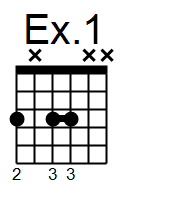 Assuming that the 3 tones being sounded areat the 5th fret, we might indeed call this structure A minor 7th.The question that needs to posed is, how many other names can wegive this shape? Assuming again that these tones are soundingat the 5th fret, we hear A, G and C, from bottom to top.
Assuming that the 3 tones being sounded areat the 5th fret, we might indeed call this structure A minor 7th.The question that needs to posed is, how many other names can wegive this shape? Assuming again that these tones are soundingat the 5th fret, we hear A, G and C, from bottom to top.  Assuming that the 3 tones being sounded areat the 5th fret, we might indeed call this structure A minor 7th.The question that needs to posed is, how many other names can wegive this shape? Assuming again that these tones are soundingat the 5th fret, we hear A, G and C, from bottom to top.
Assuming that the 3 tones being sounded areat the 5th fret, we might indeed call this structure A minor 7th.The question that needs to posed is, how many other names can wegive this shape? Assuming again that these tones are soundingat the 5th fret, we hear A, G and C, from bottom to top.
Therefore,this structure may also sound as: 1. C6 2. F Major 9th 3. Bb Major 13th 4. D minor 11th Other sounds are possible, of course, but wewill stick with the more commonly used substitutions. Using the 5possible chord names we've established for this shape, consider fora moment the number off possible uses for this littlestructure.
Next, let's talk a bit regarding fingerings.I've presented one fingering above. How many others are possible?What would be the advantages of each alternate fingering? With the fingering pictured above, noticethat both fingers 1 and 4 are free. This affords a great deal offlexibility; you can easily move in either direction en route tothe next shape. What if we change the fingering to thearrangement shown below? 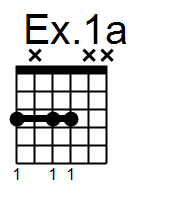
Font size:
Interval:
Bookmark:
Similar books «A Chord-Melody Methodology for Guitar»
Look at similar books to A Chord-Melody Methodology for Guitar. We have selected literature similar in name and meaning in the hope of providing readers with more options to find new, interesting, not yet read works.
Discussion, reviews of the book A Chord-Melody Methodology for Guitar and just readers' own opinions. Leave your comments, write what you think about the work, its meaning or the main characters. Specify what exactly you liked and what you didn't like, and why you think so.

